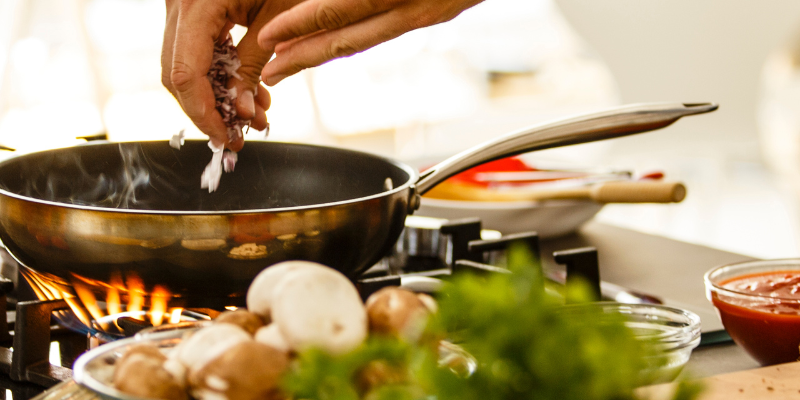The Ultimate Salad Primer: Prep, Store and Create Killer Salads
joy of nesting
Salad preparation is an art! Okay, maybe I’m exaggerating a bit, but it does involve a few tools, techniques and a little knowledge to do it well. This week’s Joy of Nesting will give you The Ultimate Salad Primer: a primer on how to prep, store and create killer salads.

I’ll give you my own processes involving the right ingredients, choosing the right knives, storage, making dressings from scratch; and storing them so you get maximum pleasure from minimal effort!
The Ultimate Salad Primer: Create Killer Salads
To make a variety of delicious salads on a weekly basis, keep the following ingredients on hand:
Leafy Greens: These form the base of most salads. Options include romaine lettuce, spinach, arugula, kale, and mixed greens. Romaine, spinach and mixed greens are versatile and taste good with most everything.
Kale and arugula are fairly distinct and taste best when combined with few ingredients. Kale is great with Parmesan cheese, lemon juice and pine nuts. Arugula is good with peaches or beets.
Vegetables: Tomatoes, cucumbers, bell peppers, carrots, radishes, and avocados are all great choices. You can also consider roasted or sauteed green beans or Brussel sprouts but keep in mind raw vegetables have more nutrients.
Cooked vegetables are devoid of micronutrients but still, I feel there is always a place in our diet for some cooked foods.
Cooked foods add to our enjoyment and satisfaction. They are also warming foods which are so comforting to women in the colder months.
Other Salad Ingredients
Proteins: Kidney beans, garbanzo, black beans, and raw or toasted nuts are a delicious way to add protein to your salads. Have a little brown rice or quinoa and you’ve got all 9 essential amino acids, aka a complete, plant based protein.
Fish and Eggs: While I don’t eat meat, I do add the occasional humanely raised eggs, wild salmon and wild shrimp to my salads.
Pasta: Consider adding pasta to make your salad more filling.
Vegetarian Non-Cow’s Milk Cheese: So many Feta, goat cheese and Pecorino add body and flavor. Keep in mind cow’s milk cheese is really hard on the digestion and creates constipation.
Nuts and Seeds: Almonds, walnuts, pecans, sunflower seeds, and pumpkin seeds, toasted or raw add protein, crunch, fat and flavor!
Herbs and Spices: Fresh herbs like basil, parsley, cilantro or spices like black pepper and paprika can elevate the taste of your salad.
Create Killer Salad Dressings from Scratch
Homemade dressings will elevate your salads. Here’s my basic vinaigrette recipe:
Combine 3 parts oil with 1 part vinegar.
Add salt, pepper, and your choice of herbs or spices.
Whisk until well combined.
Experiment with different types of oil, vinegar, and flavors to create your own signature dressing.
Incorporating some kind of acid in your salad dressing adds balance and excitement! Acids like vinegar or citrus juice can brighten up the flavors and add a refreshing tang to your sala
The key to a good dressing is balance. A basic vinaigrette typically has a ratio of 3 parts oil to 1 part vinegar or citrus juice. However, feel free to adjust this ratio to suit your taste. Happy salad making!
Store Salad Ingredients
Proper storage extends the freshness of your chopped veggies. Here are some tips:
Store chopped veggies in airtight containers in the refrigerator.
Use within 7 days for optimal freshness. Berries, avocados and peaches might be a little less depending on the time of the year, and how old they are when you first purchase them.
Some veggies can be stored with a damp paper towel to prevent drying out.
Choosing the Right Knives for Salad Prep
The key to efficient salad preparation is using the right knives. Here are a few essentials:
Chef’s Knife: This versatile knife is perfect for chopping vegetables and greens.
Paring Knife: Ideal for peeling and cutting small vegetables.
Serrated Knife: Great for slicing tomatoes and other soft vegetables.
Remember to keep your knives sharp for safe and efficient chopping.
Mastering Salad Chopping Techniques
Proper chopping techniques not only improve the appearance of your salad but also ensure even cooking for warm salads. Here are some techniques:
Chiffonade: This technique involves rolling up leafy greens and slicing them into thin ribbons.
Dice: This involves cutting vegetables.
Julienne: This technique creates thin, uniform strips of vegetables.
Using a chef’s knife correctly involves proper grip, positioning, and technique. Here’s a step-by-step guide:
Holding the Knife
Handle Grip: Hold the knife handle in your hand with your thumb and index finger on opposite sides of the handle.
Blade Grip: For more control, move your grip up. Pinch the bottom of the blade between your thumb and the side of your index finger. Wrap your three remaining fingers around the handle.
When I first found this out, I was surprised because it seems a little dangerous, but it actually makes sense now that I practice it.
Knife Position for Salad Prep
Knife Position: The tip of the knife should be in contact with the cutting board, and the knife should be angled upwards.
Hand Position: Your other hand (the guiding hand) should hold the food. Curl your fingers into a claw-like shape to keep them safe from the blade.
Executing Cuts
Slicing: With your fingers in the claw position, use a rocking motion to slice the food. Start with the back end of the knife on the board and rock forward until the tip hits the board.
Dicing: To dice, first cut off one side of the vegetable to create a flat base. Place this flat side on the cutting board for stability. Slice the vegetable lengthwise, then turn it 90 degrees and slice again.
Chopping Herbs: Gather herbs into a pile. Hold the knife handle with one hand and place your other hand on top of the blade. Use a rocking motion to chop.
Remember, always keep your knives sharp as dull knives can slip and are more dangerous than sharp ones. Practice these techniques until you’re comfortable with them, and always prioritize safety.
Best Salad Ingredients to Prep Ahead
Carrots
Broccoli
Cauliflower
Asparagus
Green beans
Onion
Other Topping Ideas
Marinated Artichoke Hearts
Roasted Beets
Roasted Brussels Sprouts
Kalamata olives
Roasted Red Bell Peppers
Storing Veggies and Leafy Greens
Store vegetables in a different part of the fridge than fruit to prevent them from spoiling.
For leafy greens, you can lay them out on a length of paper towels, loosely roll the towels and place the roll into a resealable plastic bag.
With vegetables like carrots, peppers, and broccoli and cauliflower florets, wrap them in a sheet of dry paper towel to prevent them from getting slimy and place in an airtight storage container.
Wash, separate and then dry lettuce leaves. Place the dried leaves into a resealable bag, along with a couple of sheets of paper towel to absorb the water, and store in the refrigerator.
Remember, not all fruits, veggies and leafy greens should be washed or prepped before storage.
Organizing Your Kitchen for Better Salad Prep
An organized kitchen totally levels up your lifestyle, eating habits, overall efficiency and even your sense of connection. Learn more in the download below!
Download Your Free Gift
To get started on a home where you feel healthy, happy and connected grab my complimentary design and wellness download, The Wellness Home.
It’s the prettiest little book. It’s a quick read with super easy design solutions that help you lead a beautiful, healthier lifestyle at home, plus my 3-to-5 Things Framework that gives you step by step actions to get started and stay on track.
That’s it for today. Thank you for stopping by!
Shiree’
What is Wellness Design? Learn more about the connection between your wellbeing and your home, featured on Deirdre Fitzpatrick’s Dying to Ask Podcast. And if you’d like to dive deeper into this topic, check out my blog post, “Hiring an Interior Designer”.

